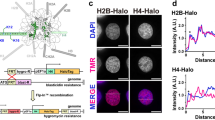Abstract
The autoradiographic analysis of exchanges in tritium-labelled meiotic chromosomes is potentially a useful approach to the study of meiotic exchange events since this method differentially labels meiotic chromatids along their entire length. The main problem encountered in earlier autoradiographic studies is that of distinguishing label exchanges generated at chiasmata from label exchanges generated by sister chromatid exchange. This problem was overcome in the present study by the choice of a meiotic system (male meiosis of Stethophyma grossum) where chiasmata are limited to just one proximally localised chiasma in each bivalent. This system allows the positive identification of chiasma-generated label exchanges and demonstrates convincingly the origin of chiasmata through breakage and rejoining of homologous non-sister chromatids. Sister chromatid exchanges are also readily detected in labelled meiotic chromosomes of this species, where they occur with a mean frequency of 0.35 per chromosome. This frequency is similar to that found in mitotic spermatogonial cells and the exchanges are randomly distributed both within and between chromosomes. These features of meiotic sister chromatid exchanges suggest that they are unrelated to non-sister chiasmatic exchanges and they probably have no special meiotic significance.
Similar content being viewed by others
References
Braver, G., Blount, J. L.: Somatic elimination of ring chromosomes in Drosophila melanogaster. Genetics 35, 98 (1950).
Brewen, J. G., Peacock, W. J.: The effect of tritiated thymidine on sister chromatid exchange in a ring chromosome. Mutation Res. 7, 433–440 (1969).
Brown, S.W., Zohary, D.: The relationship of chiasmata and crossing-over in Lilium formosanum. Genetics 40, 850–873 (1955).
Church, K., Wimber, D. E.: Meiosis in Ornithogalum virens (Liliaceae): Meiotic timing and segregation of H3-thymidine labelled chromosomes. Canad. J. Genet. Cytol. 11, 573–581 (1969).
Craig-Cameron, T. A., Jones, G. H.: The analysis of exchanges in tritium-labelled meiotic chromosomes. I. Schistocerca gregaria. Heredity 25, 223–232 (1970).
Douglas, L. T., Kroes, H. W.: Meiosis. VI: A reinterpretation of tritium thymidine labelling of meiotic chromosomes, supporting the chiasmatype hypothesis. Genetica ('s-Gravenhage) 40, 503–507 (1969).
Henderson, S. A.: Time of chiasma formation in relation to the time of deoxyribonucleic acid synthesis. Nature (Lond.) 211, 1043–1047 (1966).
Howell, S. H., Stern, H.: The appearance of DNA breakage and repair activities in the synchronous meiotic cycle of Lilium. J. molec. Biol. 55, 357–378 (1971).
Jones, G. H., Craig-Cameron, T. A.: Analysis of meiotic exchange by tritium auto-radiography. Nature (Lond.) 223, 946–947 (1969).
Marin, G., Prescott, D. M.: The frequency of sister chromatid exchanges following exposure to various doses of H3-thymidine or X-rays. J. Cell Biol. 21, 159–167 (1964).
McClintock, B.: The production of homozygous deficient tissues with mutant characteristics by means of the aberrant mitotic behaviour of ring-shaped chromosomes. Genetics 23, 315–376 (1938).
Michaelis, A.: Über das Verhalten eines Ringchromosoms in der Mitose und Meiose von Antirrhinum majus L. Chromosoma (Berl.) 10, 144–162 (1959).
Peacock, W. J.: Chiasmata and crossing-over. In: Replication and recombination of genetic material (W. J. Peacock and R. D. Brock, eds.), p. 242–252. Canberra: Australian Academy of Science 1968.
—: Replication, recombination and chiasmata in Goniaea australasiae (Orthoptera: Acrididae). Genetics 65, 593–617 (1970).
Schwartz, D.: Evidence for sister strand crossing-over in maize. Genetics 38, 251–260 (1953).
Shaw, D.D.: The supernumerary segment system of Stethophyma. I. Structural basis. Chromosoma (Berl.) 30, 326–343 (1970).
Stern, C.: Zytologisch-genetische Untersuchungen als Beweise für die Morgansche Theorie des Faktorenaustauschs. Biol. Zbl. 51, 547–587 (1931).
Taylor, J. H.: Distribution of tritium-labelled DNA among chromosomes during meiosis. I. Spermatogenesis in the grasshopper. J. Cell Biol. 25, 57–67 (1965).
Westerman, M.: The effect of X-irradiation on male meiosis in Schistocerca gregaria (Forskål). I. Chiasma frequency response. Chromosoma (Berl.) 22, 401–416 (1967).
White, M. J. D.: Chiasma localisation in Mecostethus grossus. L. and Metrioptera brachyptera L. (Orthoptera). Z. Zellforsch. 24, 128–135 (1936).
Whitehouse, H. L. K.: Towards an understanding of the mechanism of heredity. 2nd ed. London: Edward Arnold 1969.
Wolff, S.: Are sister chromatid exchanges sister strand crossovers or radiation induced exchanges ? Mutation Res. 1, 337–343 (1964).
—, Heddle, J. A.: Some chromosome studies with tritiated thymidine. In: Replication and recombination of genetic material (W. J. Peacock and R. J. Brock, eds.), p. 105–113. Canberra: Australian Academy of Science 1968.
Author information
Authors and Affiliations
Rights and permissions
About this article
Cite this article
Jones, G.H. The analysis of exchanges in tritium-labelled meiotic chromosomes. Chromosoma 34, 367–382 (1971). https://doi.org/10.1007/BF00326312
Received:
Accepted:
Issue Date:
DOI: https://doi.org/10.1007/BF00326312




